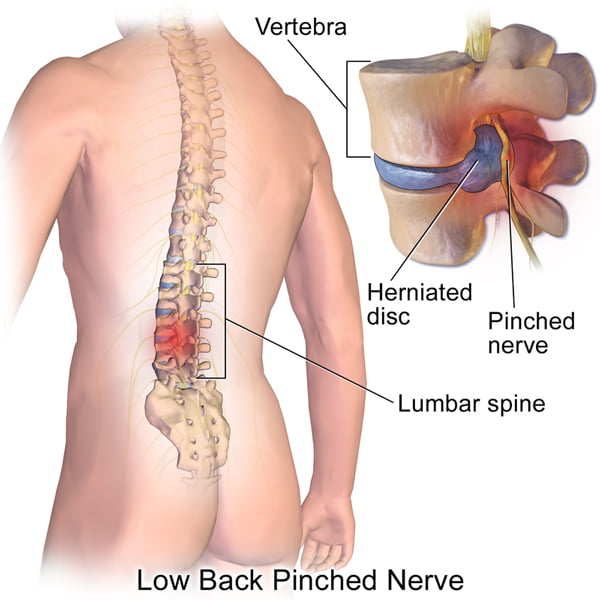Can Ergonomic Chairs Help with Sciatica and Pinched Nerves? Insights and Solutions
- Updated:
About the author:
Ronel Hendry

Share this post:
Take a moment to imagine your daily routine as an office worker. How many hours do you spend sitting down? Whether it's typing away at your computer or attending back-to-back meetings, chances are you're glued to your seat more than you'd like to admit. Now, picture this: have you ever experienced a sharp persistent pain that seems to permeate every movement? If you have, you're probably familiar with the agonising pain of sciatica or a pinched nerve. These conditions don't just disrupt your workdays; they invade your life, casting shadows over even the simplest tasks. As someone who walked the same path and grappled with persistent pain, I understand this uphill battle! However, amidst the struggle, I've discovered a glimmer of hope: ergonomic chairs and the power of a well-designed workstation can help with sciatica and pinched nerve pain. How Ergonomic Chairs Transformed My Work Life – My Journey with Nerve Pain in My Lower Back
As an office ergonomic risk facilitator armed with both expertise and first-hand experience, my goal is to help you take control of your sciatica and pinched nerve discomfort and to create a workspace that supports your health and wellbeing. Let's embark on this journey together and explore how ergonomic and orthopedic office chairs can help combat sciatica and pinched nerve pain. But before we continue let’s take a moment to understand the differences between sciatica and pinched nerves in the lower back.
Sciatica
Sciatica is caused by compression, irritation, or damage to the sciatic nerve. This nerve runs from your lower back, through the hips and buttocks, and branches down the back of each leg.
The most common cause of sciatica is a herniated disc in your lower back. Prolonged sitting increases pressure on these discs, and over time, a disc can bulge or even break, causing pressure on and irritation of the sciatic nerve.
Sciatica pain mainly occurs in the lower back, hips, buttocks, and legs.

Sciatica causes pain along the path of the sciatic nerve.

Pinched Nerve in the Lower Back
A pinched nerve happens when pressure or force is put on a region of a nerve, typically due to an injured nerve in the lumbar spine.
The most common causes of pinched nerves are herniated disks, bone spurs, or muscle tightness.
Signs and symptoms of a pinched nerve consist of a stinging pain, such as pins and needles, tingling
muscles, weakness, numbness, and burning pain in the lower back.
A pinched nerve in the lower back causes pain where the nerve has been pinched.
Ergonomic Chairs can Help Alleviate Sciatica and Pinched Nerve Pain
Ergonomic office chairs can help with sciatica and pinched nerve pain. They’re not just pieces of furniture, but lifelines for anyone navigating the challenging journey of chronic pain. Ergonomic chairs play a pivotal role in creating a workspace conducive to alleviating sciatica and pinched nerve discomfort and promoting overall spinal health. Ergonomics and Sciatica
Why are ergonomic chairs indispensable in the battle against back pain?
a) Optimal Support
When you sit in an ergonomic chair, you'll notice how it's designed to provide targeted support to key areas of your body, like your lumbar region. This support is essential for maintaining proper spinal alignment, which in turn helps to relieve pressure on your lower back and reduce strain on your sciatic or pinched nerves. Back support for an office chair – why it’s important
b) Customisable Features
Ergonomic chairs have a range of adjustable features, allowing you to find the perfect chair suited to your unique body dimensions and preferences. What is an ergonomic chair? From adjustable lumbar support to seat depth and armrest height, just to name a few, these features allow you to create a personalised and comfortable seating experience. How are ergonomic chairs made?
c) Postural Alignment
Poor posture is a common contributing factor to sciatica and pinched nerve pain. Ergonomic chairs encourage proper postural alignment by promoting a neutral spine position and distributing body weight evenly. Ergonomic chairs that enable dynamic sitting alleviate muscle tension, improve blood circulation, and help with sciatica and pinched nerve pain.
d) Enhanced Circulation
Prolonged sitting can lead to restricted blood flow and circulation, intensifying sciatica and pinched nerve discomfort. Ergonomic chairs with a synchronous (synchro) or free-float mechanism encourage dynamic sitting and are designed with features such as seat pan tilting and waterfall seat edges, which promote better circulation by reducing pressure on the thighs and buttocks. Improved circulation not only relieves discomfort, but also enhances overall comfort and productivity.
e) Long-Term Health Benefits
Investing in an ergonomic chair is an investment in long-term spinal health. By providing consistent support and promoting proper posture, these chairs can help prevent musculoskeletal injuries and alleviate chronic pain associated with sciatica and pinched nerves. Moreover, maintaining good spinal health can have far-reaching benefits, including improved mobility, reduced risk of degenerative conditions, and enhanced wellbeing. How Much Should You Budget for an Ergonomic Office Chair?
Beat Back Pain: The Ultimate Office Chair and Desk Setup Guide
Ergonomic chairs are specifically designed to provide optimal support and comfort.
If your workstation is set up correctly, it can help alleviate sciatica and pinched nerve pain in your lower back.
To improve comfort and "Beat Back Pain", watch our video where we provide practical tips for setting up the ultimate ergonomic workstation. 8 Common Mistakes when Setting Up an Ergonomic Chair.
Ergonomic chairs and your workstation set up is just one piece of the puzzle. Healthy habits and movement play a pivotal role in helping with your sciatica and pinched nerve pain.
Importance of Healthy Habits and Movement

a) Regular Exercise:
Regular non-strenuous exercise will strengthen your muscles and improve flexibility. Focus on exercises that target the core, back, and legs, such as walking or swimming. Strengthening these muscles can help support your spine and alleviate pressure on the sciatic nerve.
b) Maintain Good Posture
Practice good posture throughout the day, whether sitting, standing, or walking as this will help with sciatica pain. Avoid slouching or arching your back excessively, as this can aggravate sciatica and pinched nerve pain. Instead, imagine a string pulling you up from the top of your head, lengthening your spine and maintaining alignment.
c) Stay Hydrated and Eat Well
Hydration and nutrition play a crucial role in overall health and wellbeing. Drink plenty of water throughout the day to keep your body hydrated and maintain spinal disc health. Incorporate a balanced diet rich in fruits, vegetables, lean proteins, and whole grains to support optimal nerve function and reduce inflammation.
d) Mindful Practices
Incorporate mindfulness practices into your daily routine. For example, deep breathing promotes relaxation and reduces stress. Visualising a peaceful and serene place in your mind can also help reduce stress and promote relaxation.

e) Take Regular Breaks
Incorporate short breaks into your workday to stretch and move around. Simple exercises and movement improve blood circulation can help release tension in the muscles surrounding the sciatic nerve, providing relief from pain and discomfort.
Here are some simple desk-friendly exercises:
Seated Spinal Twist
Sit up straight, cross one leg over the other, then twist your torso gently towards the crossed leg. Hold for a few seconds, then switch sides.
Seated Forward Bend
Sit on the edge of your chair, feet flat on the floor. Slowly bend forward from your hips, reaching towards your feet or the floor. Hold for a few breaths.
Knee to Chest Stretch
While seated, bring one knee towards your chest, holding it with both hands. Hold for 15-30 seconds, then switch legs.
Standing Desk Back Stretch
Place both hands on top of the standing desk, bring your feet together. Bend at the hips and lower the upper body between your arms. Keep your hands on the desk. Hold this stretch for 30 seconds
Listen to your body. If any exercise increases pain, stop immediately. Consult your healthcare professional before starting any new exercise routine, especially if you have an underlying condition like sciatica or a pinched nerve.
Essential Tools for Creating a Healthy Workspace
1. Ergonomic Chair
Invest in an ergonomic chair with adjustable features including:
- Good lumbar support to cradle the lower back. Back support for an office chair – why it’s important
- Adjustable seat depth (seat slider) to ensure there is sufficient distance between the seat edge and back of thighs, and to ensure proper alignment and adequate support for the thighs. These office chairs have a seat slider.
- A seat with a waterfall front edge to promote healthy circulation and minimise pressure points.
- A tilting mechanism that promotes dynamic sitting.
- Armrests support your elbows and forearms and make it easier to get up from the chair.
- Common Issues with Ergonomic Chairs and Practical Solutions for a Pain-Free Workday
2. Standing Desk
A standing desk or a desk converter allows you to alternate between sitting and standing throughout the day. Standing periodically can help reduce pressure on the lower back and improve circulation which helps with sciatica and pinched nerve discomfort. Advantages of a Standing Desk
3. Ergonomic Accessories
Ergonomic accessories such as footrests and monitor stands can elevate your workstation to new heights of comfort and efficiency.
Consulting with an Office Ergonomics Risk Facilitator
Ergonomic chairs can help with sciatica and pinched nerve pain, but before making any decisions, consult an expert. Our office ergonomics risk facilitators can assist you in identify the correct chair and workstation setup tailored to your individual needs. Contact Us for more information.
By the same author:

Types of Leather: Understanding Your Options
Leather, Bonded Leather or Faux Leather Office Chair?
There are big differences between the types of leather used for office chairs.

The ultimate ‘how to’ video guide of exercises and stretches for office workers
Improve concentration and wellbeing while reducing stress.

Sitting Ducks: How to Protect Your Health in the Age of the Office Chair
Am I sitting too much? The answer is “probably”.

